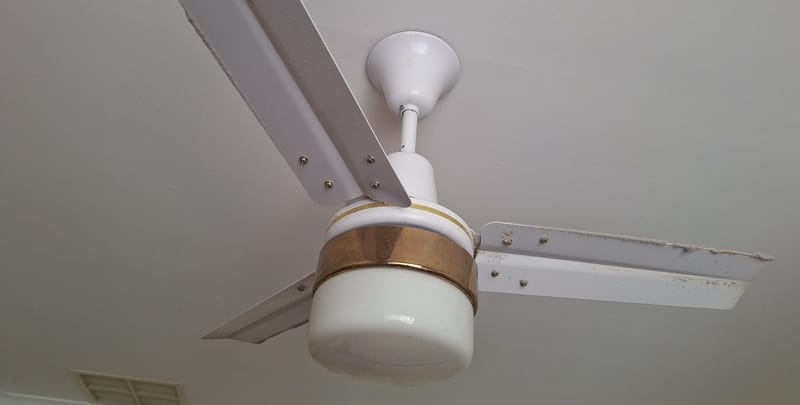
Experience Optimal Airflow In Your Home
A high speed ceiling fan is designed to keep your home comfortable by moving air throughout the room. They may not necessarily cool the air like an air conditioner or evaporative cooler will. But when ceiling fans work in conjunction with those particular cooling appliances, they can be particularly helpful in amplifying the cooling effect.
Sometimes, though, even the best ceiling fans can lose their edge. They gradually start running slower than usual and leave you wondering why. When airflow isn’t what it used to be, it’s usually down to a few common issues that can affect performance. So let’s shed some light on 5 of the most common causes behind ceiling fans suddenly being unable to perform to expectations.
1. Dust and Dirt Build-Up on Fan Blades
Dust and dirt build-up on fan blades can quickly impact the performance high-speed ceiling fans, causing them to run slower and reducing their airflow. Ceiling fan blades gather dust over time; this dust adds extra weight and creates an uneven resistance. Both these factors combined make the fan work harder and ultimately slow it down.
Regular cleaning does more than merely improve the fan’s speed. It also keeps your home’s air fresher by stopping dust particles from circulating. Simply wiping down the blades once every few weeks can make a significant positive impact on the performance of your fan. It goes a long way toward maintaining its optimal speed and providing the cooling comfort you rely on.

2. Issues with the Capacitor
For many of us, the only capacitor we might be aware of is the flux variety that is crucial to the plot of the movie Back to The Future. But a capacitor is also a small yet essential component of your ceiling fan. It regulates the electric current to help the fan run at its required speed.
So what happens when the capacitor starts to wear out or fail? The fan will likely struggle to reach optimal airflow and will start spinning slower or inconsistently.
Capacitor issues typically emerge over time, making your ceiling fan’s performance unpredictable. For a licensed electrician, replacing a faulty capacitor is usually straightforward. To prevent further strain on the fan’s motor, you need to address the problem as soon as possible. A quick fix here can restore your fan’s smooth, efficient operation.
3. Loose or Worn Motor Bearings
Loose or worn motor bearings can be a common reason why your high-speed ceiling fan isn’t performing as it should.
Bearings allow the motor in your ceiling fan to spin smoothly, helping to create the necessary airflow that brings a cooling effect to your home. But much like the capacitor, these bearings can wear out over time. They can also loosen or even become dirty, which increases friction and forces the motor to work harder. This effectively slows down the fan.
Regular maintenance, like lubricating the motor bearings, can help prevent this issue. If you experience grinding or humming sounds, it may be time to call a professional for a qualified inspection. If it’s necessary, they’ll replace the bearings to restore full performance.
4. Electrical Connection Issues
Electrical connection issues can easily cause your high speed ceiling fan to run slower than it should. Over time, wiring connections within the fan or the ceiling can loosen or start corroding. This diminishes the power flow and impacts the general performance of the fan. Even minor disruptions in the electrical supply can cause the fan’s motor to perform below its usual standards, effectively resulting in lower airflow.
Ceiling fan inspections by a licensed electrician can identify these issues early on. Addressing connection problems helps restore the fan’s designed speed while also keeping it running safely and efficiently in your home.

5. An Overloaded Circuit
Finally, an overloaded circuit can be the reason your high speed ceiling fan isn’t reaching its full potential.
Connecting too many appliances to the same electrical circuit stretches the power supply. This affects the performance of everything plugged in, including your ceiling fan. This reduction in available power can cause the fan to slow down, reducing airflow and making your home feel warmer.
Distributing power-heavy appliances across different circuits or consulting an electrician to add more options can solve this issue. Ensuring an adequate power supply allows your ceiling fan to perform optimally without interruption.
Quick Tips to Maintain Ceiling Fan Performance
Regular maintenance can keep your high speed ceiling fan running smoothly, ensuring optimal airflow and performance for a comfortable home. Here are some simple tips to help maintain your ceiling fan’s efficiency:
- Clean fan blades regularly to prevent dust build-up that can slow down the fan and reduce airflow.
- Inspect and tighten loose screws on the fan blades and motor housing to keep everything secure and running quietly.
- Check the capacitor and have an electrician replace it if necessary.
- Lubricate motor bearings if your fan allows, as this reduces friction and prolongs motor life.
- Balance the fan blades to avoid wobbling, which can lead to wear and decrease airflow.
With these easy steps, you can keep your ceiling fan operating efficiently and enjoy consistent cooling throughout your home.
Trust a Licensed Electrician to Restore Ceiling Fan Airflow
When dealing with electrical issues affecting your high speed ceiling fan, it’s essential to call a licensed electrician. While DIY fixes might be tempting, attempting to repair or troubleshoot wiring yourself can be risky and could lead to further problems—or even hazards—in your home.
Licensed electricians have the expertise to safely diagnose and fix issues, from faulty capacitors to overloaded circuits. Professional support doesn’t just restore airflow; it also gives you peace of mind and provides light to your load. You can rest easy knowing that your fan is safely wired and ready to keep your room cool and comfortable.
Please note: Thanks for reading our blog “5 Reasons Your High Speed Ceiling Fan is Running Slow”. This information is provided for advice purposes only. Regulations differ from state to state, so please consult your local authorities or an industry professional before proceeding with any work. See our Terms & Conditions here.


